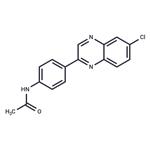CA77.1 is a potent, brain-penetrant and orally active chaperone-mediated autophagy (CMA) activator with favorable pharmacokinetics. CA77.1 is a derivative of AR7 and can increase the expression of the lysosomal receptor LAMP2A in lysosomes. CA77.1 improves behavior and neuropathology in PS19 mice model and can be used for alzheimer’s disease research[1].
CA77.1 (0-30 μM; 16 hours) activates CMA in a dose-and time-dependent manner to NIH 3T3 cells stably expressing the KFERQ-PS-Dendra reporter. The CMA activity is quantified as the average of fluorescent puncta per cell[1].CA77.1 (20 μM; 6 hours) does not alter on LC3-II expression, and does not effects autophagic flux in NIH 3T3 cells[1].
CA77.1 (oral gavage; 10 mg/kg;single dose) demonstrates brain penetrance with favorable pharmacokinetics. The Cmax, AUClast, Tmax and T1/2 are 3534 ng/g, 8338 h*ng/g, 1 hour and 1.89 hour, respectively[1].CA77.1 (oral gavage; 30 mg/kg; 6 months) normalizes the previously described locomotor hyperactivity of PS19 mice to control levels. And it reduces the levels and number of neurons containing pathogenic tau conformations in the hippocampus, amygdala, and piriform cortex. And the higher number of microglial cells and presence of large Iba1-positive cells with rod-like dystrophic morphology in vehicle-treated PS19 mice are reduced upon CA77.1 treatment[1].
![Acetamide, N-[4-(6-chloro-2-quinoxalinyl)phenyl]- Structure](/CAS/20210305/GIF/2412270-22-3.gif)

